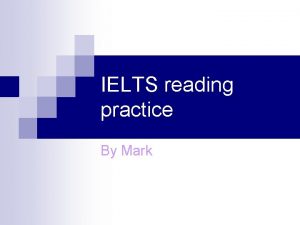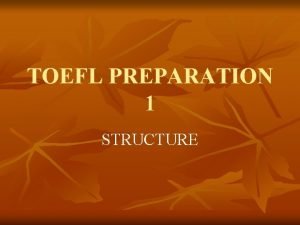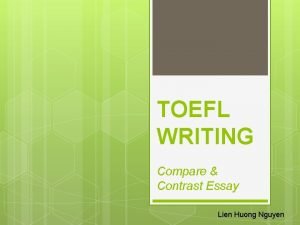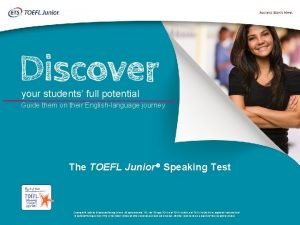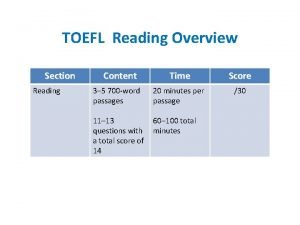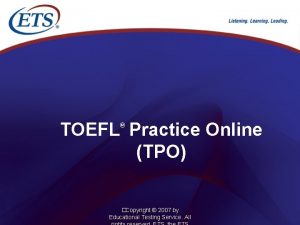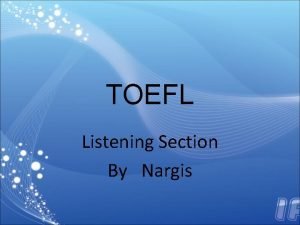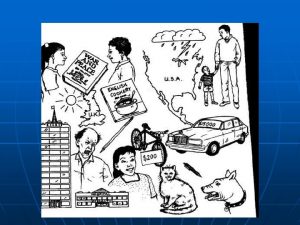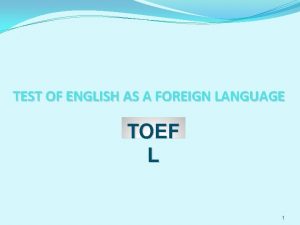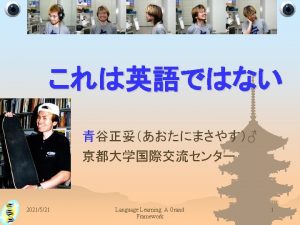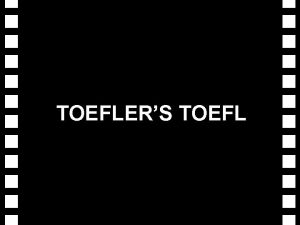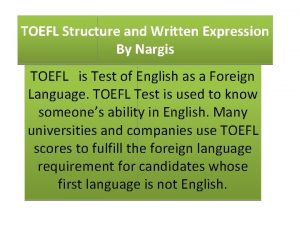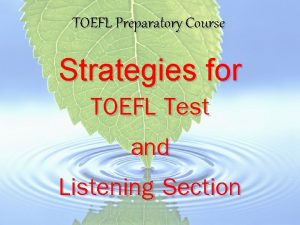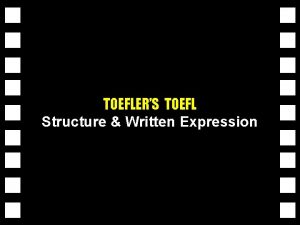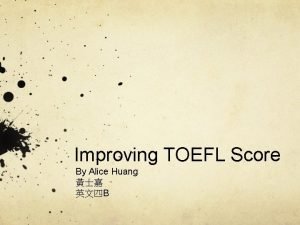An Introduction to TOEFL and IELTS tests IELTS











- Slides: 11

An Introduction to TOEFL and IELTS tests

IELTS, the International English Language Testing System, is designed to assess the language ability of candidates who want to study or work where English is the language of communication. IELTS is recognized by over 6, 000 organizations worldwide, including universities, employers, professional bodies, immigration authorities and other government agencies The international test IELTS is internationally focused in its content. For example, a range of native-speaker accents (North American, Australian, New Zealand, and British) is used in the Listening test, and all standard varieties of English are accepted in candidates’ responses in all parts of the test. The test that’s tried and trusted IELTS has been developed by some of the world’s leading experts in language assessment, and is supported by an extensive program of research, validation and test development. The level of the test IELTS is designed to assess English language skills at all levels. There is no such thing as a pass or fail

The IELTS Band Score Scale 9 Expert user 8 Very good user 7 Good user 6 Competent user 5 Modest user 4 Limited user 3 Extremely limited user 2 Intermittent user 1 Non user 0 Did not attempt the test Students usually need a score somewhere between bands 5 and 7 to enter an American university

Test Format The Academic module is for candidates wishing to study at undergraduate or postgraduate levels, and for those seeking professional registration. The General Training module is for candidates wishing to migrate to an English speaking country (Australia, Canada, New Zealand, UK), and for those wishing to train or study at below degree level.

Listening Academic Reading General Training Reading Academic Writing General Training Writing Speaking

The Test Components Listening Reading Timing: About 30 minutes + 10 minutes to transfer answers Timing: 60 minutes Questions: There are 40 questions A variety of question types is used Test Parts: There are 4 sections Test Parts: There are 3 sections: The total text length is 2150 – 2750 words. Section 1 is a conversation between 2 people set in an everyday social situation. Section 2 is a monologue set in everyday social context Academic Reading Each section contains one long text. Texts are authentic and are taken from books, journals, magazines and newspapers. Section 3 is a conversation between up to four people set in an educational or training content. General Reading Section 4 is a monologue on an academic subject. Section 2 Each section is heard only once Section 1 Section 3

The Test Components Speaking Writing Timing: 60 minutes Questions: There are 2 parts Candidates are required to write at least 150 words for Task 1 and 250 words for Task 2 Questions: There are 40 questions Academic Writing In Task 1, candidates are presented with a graph, table, chart or diagram and are asked to describe, summarize or explain the information in their own words. In Task 2, candidates are asked to write an essay in response to a point of view, argument or problem. A variety of question types is used Test Parts: There are 3 sections: The total text length is 2150 – 2750 words. Academic Reading Each section contains one long text. Texts are authentic and are taken from books, journals, magazines and newspapers. General Reading (purposely omitted for TESL Training) General Training Writing Section 1 In Task 1, candidates are presented with a situation and are asked to write a letter requesting information or explaining the situation. In Task 2, candidates are asked to write an essay in response to a point of view, argument or problem. Section 2 Section 3

The TOEFL® test is the most widely respected English-language test in the world, recognized by more than 9, 000 colleges, universities and agencies in more than 130 countries, including Australia, Canada, the U. K. and the United States.

The Test Components Section Time Limit Questions Tasks Reading* 60– 80 minutes 36– 56 questions Read 3 or 4 passages from academic texts and answer questions. Listening 60– 90 minutes 34– 51 questions Listen to lectures, classroom discussions and conversations, then answer questions. Break 10 minutes — — 6 tasks Express an opinion on a familiar topic; speak based on reading and listening tasks. 2 tasks Write essay responses based on reading and listening tasks; support an opinion in writing. Speaking Writing 20 minutes 50 minutes

TOEFL® Score Scales Skill Reading Score Range 0– 30 Level High (22– 30) Intermediate (15– 21) Low (0– 14) Listening 0– 30 High (22– 30) Intermediate (15– 21) Low (0– 14) Speaking 0– 30 score scale Writing 0– 30 score scale Total Score 0– 120 Good (26– 30) Fair (18– 25) Limited (10– 17) Weak (0– 9) Good (24– 30) Fair (17– 23) Limited (1– 16)

What do the tests look like? Refer to other PPT

